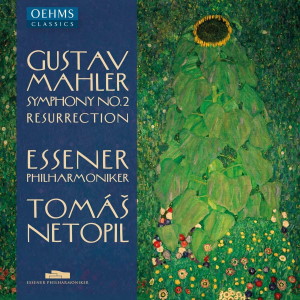
Gustav Mahler (1860-1911)
Symphony No. 2 in C minor “Resurrection”
Giulia Montanari (soprano), Bettina Ranch (alto)
Prager Philharmonischer Chor
Essener Philharmoniker/Tomáš Netopil
rec. 2019, Alfried Krupp-Saal, Philharmonie Essen
German texts and English translation
Oehms Classics OC1717 [85]
Attractively presented in a cardboard digipack, the cover, booklet and CD itself adorned with what is now almost a trope in a Gustav Klimt painting (“Sonnenblume”/Sunflower), this new recording of the “Resurrection” symphony manages to squeeze over 85 minutes onto a single CD.
It has a lot of competition, and as time goes on that becomes stiffer. We can all point to favourite, classic recordings by such as Bernstein, Klemperer, Levine, Mehta, Solti, Tennstedt et al, so do we “need” another one? Objectively? No. But we are not rational beings and the lure of the novel is always a factor, so once again I girded my metaphorical loins to embark upon yet another excursion into one of the great artefacts of Western classical music.
My first observation on an initial listen was that the Essen Philharmonic orchestra, good as it is, has nothing like the weight and drive of my favourite versions but Netopil’s direction is otherwise unimpeachable. Balances in the recorded sound are very good, too: the grumbling double basses, strumming harp and soaring strings are all beautifully situated within the broad soundscape and there is a compelling sense of the inexorable tread of the risen dead in the march. The pause at 11:32 is nicely judged before the resumption of the stately tread and the acceleration, then deceleration, of tempo before the col legno outburst is daring; this is no dutiful run-through. Unfortunately, the orchestra simply doesn’t have the heft to do full justice to the climax at 14:57, although Netopil’s intention is clear. The same is true of the concluding C minor chromatic scale.
The lilting Ländler which is the Andante second movement is first rather briskly played, in a manner perhaps not completely consonant with Mahler’s instruction Sehr gemächlich. Nie eilen (Very leisurely. Never rush) but it is delicately executed and soon settles down to what is a conventional timing, especially as again Netopil judiciously applies pauses. Once again, I would like to hear more intensity at key points; perhaps I have overdosed on Klemperer’s versions, as the playing is still charming. The third movement scherzo is fleet and flowing, but the “death shriek” is not as overwhelming as it could be. “Urlicht” follows with no break. Contralto Bettina Ranch’s contribution is largely blameless, if rather heavy on the vibrato; nor is there any special character or beauty to her voice.
The finale begins promisingly with more power than has previously been generated by the orchestra and the distancing of the offstage horn call is convincingly managed. Yet again, Netopil presides over a rather effective extended pause before the brass chorale seven minutes in which culminates in the splendid eruption beginning at 8:24 which in turn builds to the great drum roll at 10:33 heralding “The March of the Dead”. To his credit, Netopil maintains momentum throughout and although this is a studio recording, something of the tension of a live performance is conveyed by the combination of his concentration and the skilful sound engineering. The choir’s “Aufersteh’n” creeps in atmospherically and soprano Giulia Montanari is pure of voice – but she, too, needs to rein in her vibrato. Bettina Ranch’s contribution here is rather more impressive than in “Urlicht”. It would be a poor performance indeed that could not engage the listener during that last fifteen minutes following the choir’s entry and this recording does not disappoint in that regard; the mighty finale, complete with organ, church bells and the choir singing “mit höchster Kraft” (at full power) makes it mark.
Ultimately, however, this is a well-managed, flawlessly engineered recording which offers no special claim to distinction, nor any compelling reason for its purchase as opposed to established versions unless you have an attachment to the artists or venue concerned.
Ralph Moore
Help us financially by purchasing through





















